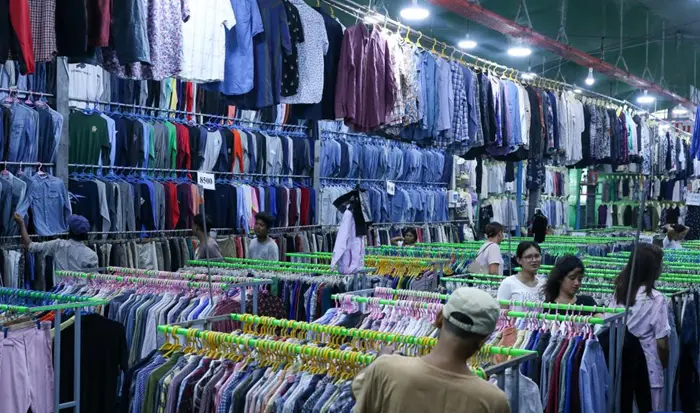YANGON, Oct. 9 (Xinhua) — As living expenses rise in Myanmar’s commercial hub of Yangon, the bustling Kyimyindaing second-hand clothing market has become a crucial destination for those seeking affordable fashion without compromising on quality.
Known locally as the Kyimyindaing night market, this vibrant marketplace is filled with an eclectic mix of pre-owned garments, drawing in shoppers looking for well-made, foreign-branded clothing at a fraction of the price of new items. The market has gained a reputation for providing budget-conscious consumers with stylish, durable attire, and has become a regular stop for many Yangon residents.
Foreign-Made Quality at Affordable Prices
Shoppers at Kyimyindaing are particularly drawn to the foreign-made garments, which are prized for their fit and durability. As the cost of new branded clothing continues to rise, often surpassing the average income of many residents, second-hand shopping has emerged as a practical alternative for balancing style and affordability.
“I can’t afford new branded items, so I come here to buy jeans and bags,” said U Win Naing, a 62-year-old regular visitor. “Since these products are used, they are cheap. And because they are foreign-made, they fit well and are of good quality,” he added.
A Thriving Market with a Global Supply Chain
For many vendors, selling second-hand clothing is a way of life. Moe Win, 35, has been running his second-hand clothing stall for the past six years, sourcing garments from countries like Japan, Thailand, and several European nations. “Most of my customers are women. We have a larger variety of women’s clothing compared to men’s,” he said, pointing to racks filled with colorful dresses and blouses.
Ma Ngu Wah, 28, who operates her own shop with the help of about 20 employees, comes from a family deeply rooted in the second-hand clothing business. “My parents sold second-hand clothing, and now my siblings and I have our own shops,” she said proudly. In her store, items start as low as 500 kyats (around 0.23 U.S. dollars), with options ranging from trousers and shirts to office suits.
Over the years, she has witnessed the evolution of the market. “Prices used to be much lower, but they have now increased significantly,” she remarked. Despite the rising costs, her shop continues to thrive, and she even has customers who buy in bulk to resell the items elsewhere. In addition to her physical store, she has expanded her business by selling second-hand clothing online.
Entrepreneurship on the Rise
The affordability of second-hand clothing has also spurred new business ventures. One such entrepreneur is Ma Nge, 48, who recently started reselling second-hand garments at a local factory. “I buy trousers and shirts for both men and women to resell,” she explained. Having only started a month ago, she is optimistic about the future. “Second-hand clothing is affordable for people with low incomes,” she noted.
For many shoppers, the economic benefits of the market are clear. Ko Aung, 32, shared his own experience of shopping at Kyimyindaing. “I bought a second-hand shoe a few months ago. The new version of this brand is too expensive for me. I also buy electronic devices and vintage clothing to save money,” he said.
With the cost of new clothing on the rise, shoppers at Kyimyindaing appreciate the value they find at the market. As one shopper pointed out, the price of one new item of clothing can often buy two or three second-hand pieces, making it a go-to destination for Yangon’s budget-conscious consumers.
The Kyimyindaing second-hand clothing market not only offers affordable fashion but has also become a vital part of the local economy, supporting both shoppers and vendors as they navigate rising costs.
Related Topics:
What to Wear to a Friend’s Birthday Dinner
What to Wear to a Professional Soccer Game
What to Wear to a Broadway Show

